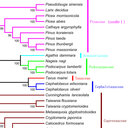Pycnogenol(®) treatment inhibits bone mineral density loss and trabecular deterioration in ovariectomized rats.
Atslēgvārdi
Abstrakts
BACKGROUND
Pycnogenol(®) extracted from French maritime pine bark (Pinus pinaster Ait. subsp. atlantica) is functional for its antioxidant activity.
OBJECTIVE
To investigate the effects of Pycnogenol(®) on bone mineral density (BMD), trabecular microarchitecture and bone metabolism in ovariectomized (OVX) rats.
METHODS
Thirty Sprague-Dawley rats were randomized into 3 groups: SHAM group (sham-operated rats), OVX group (OVX rats), and treatment group (OVX rats supplemented with 40 mg/kg Pycnogenol(®) by oral gavage). Serum levels of procollagen type I N-terminal propeptide (PINP), alkaline phosphatase (ALP) and minerals were detected at the end of 9 weeks of gavage. Deoxypyridinoline/creatinine (DPYD/Cr) and N-telopeptide of type I collagen/creatinine (NTX/Cr) rate in urine were also calculated. Left femora were collected for BMD determination, and the right distal femora were made into undecalcified specimens for histomorphometry analysis.
RESULTS
At the end of study, PINP level, DPYD/Cr and NTX/Cr rate were significantly increased, and femoral BMD were dramatically decreased in OVX group compared with SHAM group (P < 0.01) while serum minerals and ALP concentrations showed no significant difference. The treatment group had dramatically decreased biomarkers and increased BMD than OVX group (P < 0.01). Histomorphometry analysis showed worse bone microarchitecture parameters in the OVX group compared with the SHAM group which were significantly improved in the treatment group compared with the OVX group (P < 0.01).
CONCLUSIONS
Pycnogenol(®) (40 mg/kg) can inhibit aggravated bone resorption, prevent BMD loss, and restore the impaired trabecular microarchitecture in OVX rats after 9-week-intervention.



